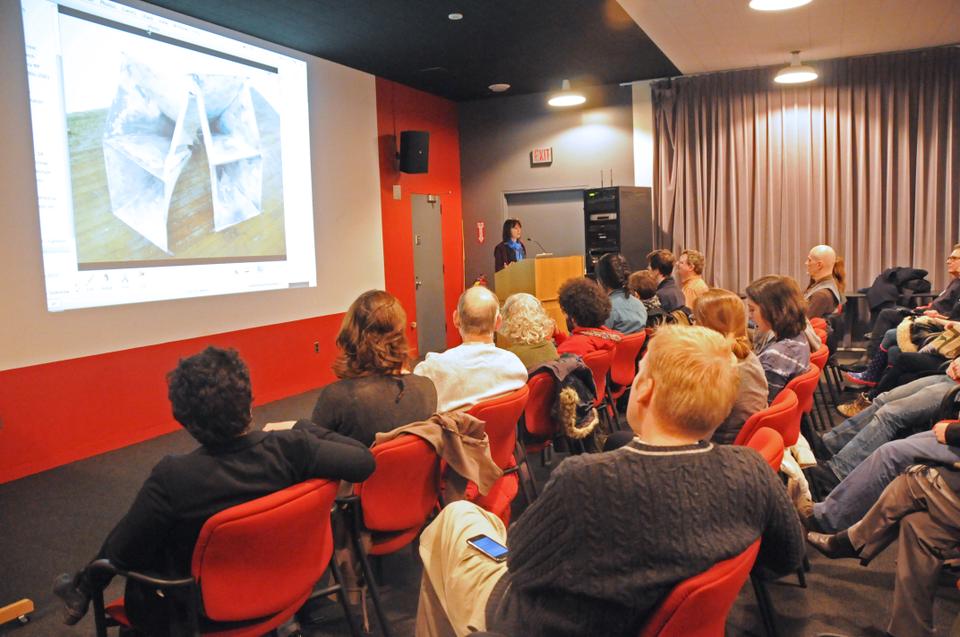
News
Pro-Palestine Encampment Represents First Major Test for Harvard President Alan Garber

News
Israeli PM Benjamin Netanyahu Condemns Antisemitism at U.S. Colleges Amid Encampment at Harvard

News
‘A Joke’: Nikole Hannah-Jones Says Harvard Should Spend More on Legacy of Slavery Initiative

News
Massachusetts ACLU Demands Harvard Reinstate PSC in Letter

News
LIVE UPDATES: Pro-Palestine Protesters Begin Encampment in Harvard Yard
Marina Rosenfeld Blends Aural and Visual Art
Artist lectures on deconstructing musical performance

“What is the bridge between visual and aural art?” This is the question Marina Rosenfeld ’90, addresses in all of her pieces, from her earliest “Sheer Frost Orchestra” to more recent installations such as “P.A. System.” The former Harvard music concentrator spoke about her art in the Carpenter Center for Visual Arts on February 7. She believes that visual and aural are “separate, superimposed modalities” of art; individual pieces of a greater artistic expression. Originally, Rosenfeld “was involved only in the aural side of that discussion,” she said. After graduating from Harvard she moved on to the California Institute of the Arts to “reverse the effects of Harvard’s regimental and fixed study of music.” As she continued in life, Rosenfeld’s “field of arts expanded” into dance, photography, and other visual arts. She has returned to Harvard not as a musician, but as a Visiting Lecturer in Visual and Environmental Studies.
Rosenfeld incorporates both sound and visuals into her installations, alongside dance, photography, costumes and interesting visual spaces. Each uses the breadth of human sense, not just one particular point on the artistic spectrum. Her propensity towards incorporating people into her works only adds to the feeling of completeness in her installations. She also includes people in order to expose them to art since “people would have to come to it if they were in it.”
Rosenfeld has a particular interest in bringing women into the art world. In her first major installation, “Sheer Frost Orchestra,” she found 17 women who had never before touched a guitar, lined them up, and had them play electric guitars lying on the ground using bottles of nail polish according to Rosenfeld’s visual cues. Another piece, “White Lines,” has a similar premise with an added visual layer. “[Musicians] interpret ... photos and video as graphic instruction and produce a performance,” Rosenfeld said.
Rosenfeld’s beginnings as a musician became apparent as she spoke about the relationship between music and sound. “The two are connected,” she said, “but not the same.” Sound is what filters through our eardrums. “Music,” she continued, “has a political meaning, a form, a history. Music implies a social connotation.” A band or an orchestra collect together to perform a piece that was written down, specifically and carefully. In her installations, Rosenfeld “gave the performers a visual system to cue the musicians” instead of traditional sheet music. She added, “I use only amateurs—though I hate that word.” Often the people in her pieces are arranged in lines. “[The line is] a form that deconstructs the classic setup of an orchestra or band,” Rosenfeld said. When an orchestra or band sit in the traditional rounded format, “those in front, like the violins and voice, seem more ‘important’ to the music, and the drums and brass in back simply provide a base.” In addition to the acoustic effects of re-arranging the performers, Rosenfeld’s work with rotating speakers blurs the sound. “[This] creates the opposite effect architects and musicians try to achieve in acoustically perfect concert halls,” she said.
More recently, she has begun to explore the idea of individual spaces in her work. In “P.A.,” she places speakers in abandoned construction sites, churches, parking lots, and various other locations and plays intermittent electronic sounds through them. The effect this creates “brings the aural component into the foreground of a situation” where most people would first look at the “pretty scenery,” Rosenfeld said. By breaking apart our standard conceptions of music (and visual art, and dance, and photography), Rosenfeld attempts to join many of the different contemporary media into a new exploration of art.
Want to keep up with breaking news? Subscribe to our email newsletter.
